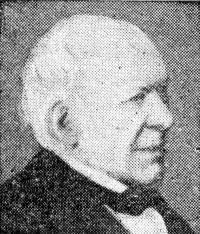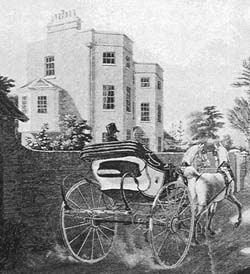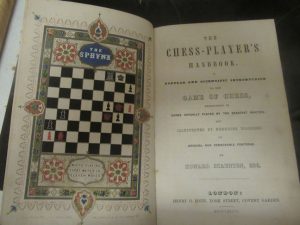We know that the first Richmond Chess Club only ran for a few years in the mid 1850s, seemingly disbanded when its prime mover, William Harris, left London.
Who were its other members? Howard Staunton and Johann Jacob Löwenthal were involved, but, one would imagine, they didn’t play an active part on a week to week basis. They enjoyed seeing their names in lights, while their connections and publicity through their magazine columns would have enhanced the club’s reputation and increased its membership.
It’s a reasonable assumption, given that the club met at his premises, that James Etherington was a member, but the only other name I’ve been able to find is that of Henry George Bohn.
A very interesting name it is, too. White I’ve no idea how strong a player he was, Henry played a very important role in the history of English chess.

Source: www.twickenham-museum.org.uk
Henry George Bohn, born in London in 1796, the son of a German father and Scottish mother, was an art collector and publisher. In 1850 he’d moved into North End House, Twickenham, on the corner of Richmond Road and Crown Road, just opposite the Crown public house (highly recommended, but also very popular, so it can get pretty crowded on rugby days). He had a walk of just under a mile to reach his chess club, no problem for a healthy chap who, even at the age of 85, would be active enough to dance the quadrille on his lawn. The house was demolished in about 1897, and a parade of shops built in its place. I haven’t yet been able to find an illustration of North End (or Northend) House.

Source: www.twickenham-museum.org.uk
In 1873 he acquired High Shot House, on the other side of Crown Road. Walking back towards Twickenham he’d very soon have reached what is now the site of Orleans Park School, home of Richmond Junior Chess Club and the Richmond Rapidplays.
Bohn was a collector of rare plants, chinaware, ivory and fine art, including works by Dürer, Van Dyck, Bruegel, Memling and Raphael, and was working to catalogue his collection until a few days before his death in 1884.
His day job, though, was more significant for our story. Henry George Bohn was a publisher, best remembered for Bohn’s Libraries. According to Wikipedia, these were begun in 1846, targeted the mass market, and comprised editions of standard works and translations, dealing with history, science, classics, theology and archaeology.
He was also a friend of the aforementioned Howard Staunton, and was the publisher of most of his chess books.

(from the author’s collection)
By the time of the foundation of the first Richmond Chess Club he’d already published The Chess Player’s Handbook (1847), The Chess-player’s Companion (1849) and The Chess Tournament (1852). These would later be joined by Chess Praxis (1860). He had also written The Chess-player’s Text Book (1849), published by J. Jaques & Son, 102 Hatton Garden, to accompany their celebrated chess sets.
Staunton, en passant, also wrote on other subjects. His edition of the plays of Shakespeare was published by George Routledge and Co in 1858. George Routledge had founded his company twenty years earlier, and they’re still going strong today, best known for their academic books. They’ve also published a few chess books, most notably the series of Routledge Chess Handbooks cashing in on the Fischer boom in the 1970s, and, more recently, Fernand Gobet’s highly recommended book on the Psychology of Chess.
Staunton also wrote a book on The Great Schools of England, published by Sampson Low, Son, and Marston, Milton House, Ludgate Hill in 1865. Sampson Low and his son, also Sampson, had started their publishing company in 1848, although Sampson senior’s father, another Sampson, had himself published books in the 1790s, and in 1856, Edward Marston became a partner in the firm. Sampson Low, like Routledge, published several chess books over the years (this might well be the subject of a future article) before stopping publishing in 1969.
In 1981 what was then the parent company was bought up by the notorious Robert Maxwell, its assets were stripped, and, 200 years after the first Sampson Low published his first book, the company was wound up.
A few years later, George Low, a journalist, editor and publisher, and direct descendant of the original Sampson, found the records in Companies House in Cardiff and re-registered the company. George’s four sons, all of whom, as it happens, were members of Richmond Junior Chess Club in the 1970s-80s, are now directors of the family firm. (Do visit their website to find out more.) The eldest boy, yet another Sampson, maintained his interest in chess, returning to the game when his son started playing, and has recently been elected Secretary of Richmond & Twickenham Chess Club. His ancestor and namesake from more than 150 years ago, would have known Howard Staunton, the President of the original Richmond Chess Club. I hope Howard will be pleased to hear this: I’ll be in touch on Twitter to let him know.
Wheels within wheels. We are all connected.
Returning to Henry George Bohn, he had hoped that his sons would continue to grow his publishing business, but it became clear that they weren’t interested, so, in 1864, he sold his business to Messrs Bell and Daldy, who would later become George Bell & Sons. Bell took over Staunton’s chess books and decided that chess would be one of their specialities. They published many chess books over the years, including classic titles by Alekhine, Capablanca, Euwe, Nimzowitsch and many British authors, continuing to publish chess books up to the late 1970s, by which time their position as England’s leading chess publisher had been usurped by Batsford, In 1986, by then Bell & Hyman, they merged with George Allen & Unwin, and the name of George Bell disappeared from the publishing world.
George seems to have been the favoured name for publishers: apart from being Bohn’s middle name, we’ve met Routledge, Bell, Allen and even Low!
The Bell inheritance, all those great Bell chess books which anyone of my generation or earlier will have grown up on and learnt from, originated with Henry George Bohn, art collector, publisher, friend of Howard Staunton – and member of the original Richmond Chess Club.
Next time you’re in Richmond Road, Twickenham, drop in at The Crown and drink a toast to Henry, the man who planted the seed which led to England’s preeminence as publishers of fine chess books.
Sources:
Wikipedia: Henry George Bohn
Twickenham Museum: Henry George Bohn
